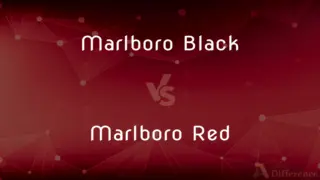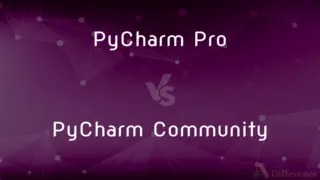1 Butanol vs. 2 Butanol — What's the Difference?
By Tayyaba Rehman — Published on December 14, 2023
1 Butanol and 2 Butanol are isomers of butanol. In 1 Butanol, the hydroxyl (OH) group is attached to the terminal carbon, while in 2 Butanol, it's on the second carbon atom.

Difference Between 1 Butanol and 2 Butanol
Table of Contents
ADVERTISEMENT
Key Differences
1 Butanol and 2 Butanol are both four-carbon alcohols, but they differ in the position of their hydroxyl group. This seemingly minor structural difference significantly impacts their chemical properties and potential applications.
In 1 Butanol, the hydroxyl group is situated on the first carbon atom at the end of the chain, making it a primary alcohol. Conversely, 2 Butanol has the hydroxyl group on the second carbon atom, categorizing it as a secondary alcohol.
The distinction between 1 Butanol and 2 Butanol isn't merely structural; it affects their reactivity. Primary alcohols like 1 Butanol often exhibit different reactivity patterns compared to secondary alcohols like 2 Butanol, especially in oxidation reactions.
Moreover, 1 Butanol and 2 Butanol have unique physical properties. While both are solvents and have similar melting and boiling points, subtle differences arise due to the position of the hydroxyl group, affecting their interactions with other molecules.
In summary, while both 1 Butanol and 2 Butanol share the commonality of being four-carbon alcohols, their distinct structures offer unique chemical behaviors, reactivity patterns, and physical properties.
ADVERTISEMENT
Comparison Chart
Hydroxyl Group Position
On the first (terminal) carbon.
On the second carbon.
Alcohol Type
Primary Alcohol.
Secondary Alcohol.
Oxidation
Can be oxidized to an aldehyde.
Typically oxidized to a ketone.
Boiling Point
Slightly higher due to terminal hydroxyl group.
Slightly lower due to internal hydroxyl group.
Molecular Structure
Straight chain with terminal OH.
Branched with central OH.
Compare with Definitions
1 Butanol
1 Butanol has a straight-chain structure with four carbons.
Due to its structure, 1 Butanol can be oxidized to butanal.
2 Butanol
2 Butanol is distinguished from other butanol isomers by its central hydroxyl location.
The position of the OH group in 2 Butanol affects its physical properties.
1 Butanol
1 Butanol is a primary alcohol with the hydroxyl group attached to the terminal carbon.
1 Butanol is often used as a solvent in the manufacture of plastics.
2 Butanol
2 Butanol is a secondary alcohol with the hydroxyl group on the second carbon atom.
2 Butanol is less reactive than its primary counterpart in certain reactions.
1 Butanol
1 Butanol serves as a precursor for other chemical compounds.
1 Butanol can be dehydrated to form butene.
2 Butanol
2 Butanol features a branched structure due to its internal hydroxyl position.
2 Butanol's structure allows it to be oxidized to butanone.
1 Butanol
1 Butanol belongs to the alcohol family, characterized by its hydroxyl group on the end carbon.
The presence of the OH group in 1 Butanol makes it polar.
2 Butanol
2 Butanol can act as a solvent and intermediate in chemical synthesis.
2 Butanol is utilized in the production of flavors and fragrances.
1 Butanol
1 Butanol possesses a higher boiling point compared to its isomers.
1 Butanol's boiling point is influenced by its terminal hydroxyl group.
2 Butanol
2 Butanol has a slightly different boiling point from its isomers due to its structure.
2 Butanol's boiling point is determined by its internal hydroxyl group.
Common Curiosities
How does 2 Butanol differ from 1 Butanol?
2 Butanol has its hydroxyl group on the second carbon, making it a secondary alcohol.
Can both 1 Butanol and 2 Butanol be used in the production of plastics?
Yes, both can be used, but 1 Butanol is more commonly utilized.
How do the structures of 1 Butanol and 2 Butanol differ?
1 Butanol has a straight chain, while 2 Butanol is branched due to its internal hydroxyl group.
Which can be oxidized to form a ketone, 1 Butanol or 2 Butanol?
2 Butanol can be oxidized to form a ketone.
What is 1 Butanol?
1 Butanol is a primary alcohol with the hydroxyl group attached to the first carbon.
Are both 1 Butanol and 2 Butanol used as solvents?
Yes, both can serve as solvents, but their specific applications might vary.
Is 1 Butanol a common ingredient in the cosmetics industry?
Yes, 1 Butanol can be found in some cosmetic products.
Where is the OH group positioned in 1 Butanol?
In 1 Butanol, the OH group is on the terminal carbon.
Is 2 Butanol a primary or secondary alcohol?
2 Butanol is a secondary alcohol.
Which is more commonly found in fragrances, 1 Butanol or 2 Butanol?
2 Butanol is more commonly utilized in the production of fragrances.
Which is more reactive in oxidation, 1 Butanol or 2 Butanol?
1 Butanol is typically more reactive, oxidizing to an aldehyde, while 2 Butanol oxidizes to a ketone.
Which has a higher boiling point, 1 Butanol or 2 Butanol?
1 Butanol generally has a slightly higher boiling point.
Which isomer of butanol, 1 Butanol or 2 Butanol, is more commonly found in industry?
Both have industrial applications, but 1 Butanol is often more commonly used due to its reactivity and solvent properties.
How can I differentiate between 1 Butanol and 2 Butanol by structure?
1 Butanol has a terminal hydroxyl group, while 2 Butanol's hydroxyl group is on the second carbon.
Are 1 Butanol and 2 Butanol the only isomers of butanol?
No, there are other isomers like isobutanol and tert-butanol.
Share Your Discovery

Previous Comparison
Disodium EDTA vs. Tetrasodium EDTA
Next Comparison
Stars vs. PlanetsAuthor Spotlight
Written by
Tayyaba RehmanTayyaba Rehman is a distinguished writer, currently serving as a primary contributor to askdifference.com. As a researcher in semantics and etymology, Tayyaba's passion for the complexity of languages and their distinctions has found a perfect home on the platform. Tayyaba delves into the intricacies of language, distinguishing between commonly confused words and phrases, thereby providing clarity for readers worldwide.













































